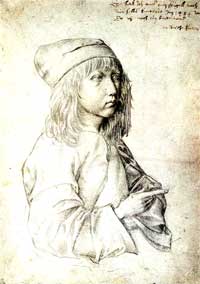Albrecht Dürer - Early Years
The artist’s father, Albrecht Dürer the Elder came to Nuremberg from Hungary in 1455. He worked as an assistant of the master goldsmith Hieronymus Holper, whose daughter, Barbara, he married in 1467. They had eighteen children.

Self-Portrait at Thirteeen Years, 1484
Graphische Sammlung Albertina, Vienna
Their second son, named Albrecht Dürer, after his father, was born on May 21 1471. Albrecht’s godfather was Anton Koberger, the future publisher of the Nuremberg Chronicle.
It is interesting to note that the original family name of Albrecht’s father, Ajtós, derived from Aito (door in Hungarian). It appears that his father’s family belonged to the small Hungarian nobility, and the Dürer family ended up using their crest, showing the open doors under a penthouse roof.
At the time of Albrecht’s birth, his father was renting the house from the rich Pirkheimer family. Six months before, the artist’s future lifelong friend, Willibald Pirkheimer, statesman, humanist, reformer, and soldier was born at Eichstadt.
Albrecht Dürer acquired his reading and writing skills at an early age, when his father sent him to the neighbourhood school. After learning to read and write, his father started to teach him the goldsmith’s work. However, the artist wrote that “My inclination carried me more towards painting than to the goldsmith work.”
In 1484, when he was only thirteen, he made his self-portrait by looking in a mirror, as the artist himself noted on the drawing: “This I have drawn from myself from the looking-glass, in the year 1484 when I was still a child.” At fourteen, he drew the "Virgin and Child Enthroned," with two tall angels standing beside the throne making music.
His wise father was very proud of him, he saw the boy’s talent, and in 1486 apprenticed him to the painter Michael Wolgemut, “to serve him for three years.”
Michael Wolgemut is remembered more as the mentor of Dürer than for his own artistic achievements.
Without intending to do him justice, we shall mention that, far from being a simple copyist, he definitely influenced Dürer, both in engraving and painting. It is known that the artist’s master copied forty eight of Schongauer's engravings. Although he never met him, Dürer’s early works are showing a certain Schongauer influence, and this is probably due to his master work.
As a painting apprentice, Dürer learned the technical process, the chemistry and the preparation of colors. He also gained knowledge of wood and copper engraving. The artist does not say much about his experience during his apprenticeship (Lehrjahre). He is just saying that he “learnt well” and also that he “had much to suffer” from his fellow apprentices, probably due to his more delicate and sensible nature.
In 1490, Albrecht Dürer finished the Lehrjahre, and his father prepared everything so his son can leave for the Wanderjahre, the German custom consisting in a mandatory journey for any craftsman who wanted to establish his own business and have his own apprentices. The Wanderjahre was subject to strict rules, and the traveller had to document where he had been in his Wanderbuch. The journey was meant to improve the craftsmen character and skills in new, challenging environments.
Next - The Wanderjahre
